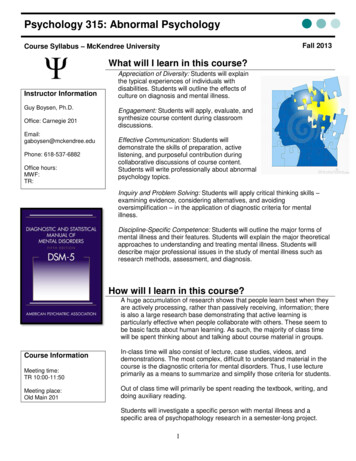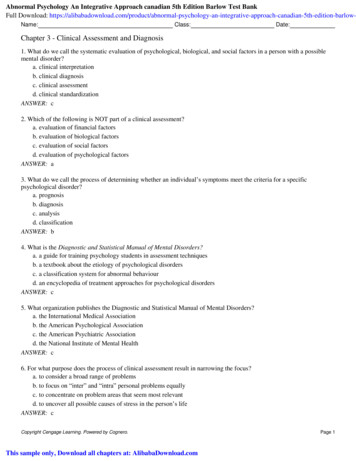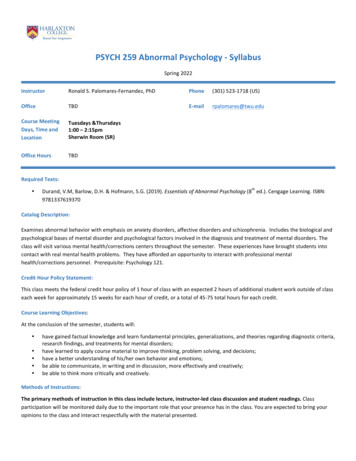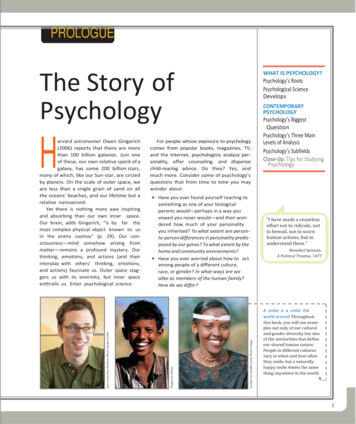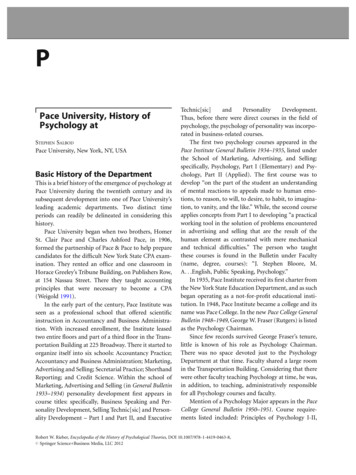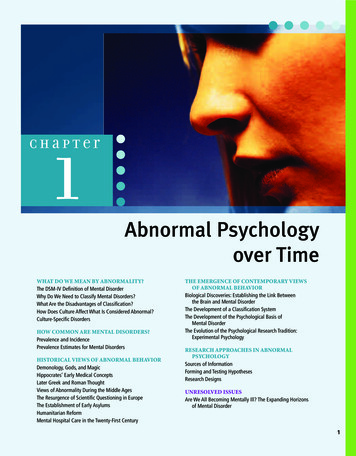
Transcription
Chapter1Abnormal Psychologyover TimeWHAT DO WE MEAN BY ABNORMALITY?The DSM-IV Definition of Mental DisorderWhy Do We Need to Classify Mental Disorders?What Are the Disadvantages of Classification?How Does Culture Affect What Is Considered Abnormal?Culture-Specific DisordersHOW COMMON ARE MENTAL DISORDERS?Prevalence and IncidencePrevalence Estimates for Mental DisordersHISTORICAL VIEWS OF ABNORMAL BEHAVIORDemonology, Gods, and MagicHippocrates’ Early Medical ConceptsLater Greek and Roman ThoughtViews of Abnormality During the Middle AgesThe Resurgence of Scientific Questioning in EuropeThe Establishment of Early AsylumsHumanitarian ReformMental Hospital Care in the Twenty-First CenturyTHE EMERGENCE OF CONTEMPORARY VIEWSOF ABNORMAL BEHAVIORBiological Discoveries: Establishing the Link Betweenthe Brain and Mental DisorderThe Development of a Classification SystemThe Development of the Psychological Basis ofMental DisorderThe Evolution of the Psychological Research Tradition:Experimental PsychologyRESEARCH APPROACHES IN ABNORMALPSYCHOLOGYSources of InformationForming and Testing HypothesesResearch DesignsUNRESOLVED ISSUESAre We All Becoming Mentally Ill? The Expanding Horizonsof Mental Disorder1
2CHAPTER 1Abnormal Psychology over Timebnormal psychology is concerned with understanding the nature, causes, andtreatment of mental disorders. The topics and problems within the field of abnormalpsychology surround us every day. You have only to pick up a newspaper, flip througha magazine, surf the Internet, or sit through a movie to be exposed to some of the issues thatclinicians and researchers deal with on a daily basis. Almost weekly some celebrity is in thenews because of a drug or alcohol problem, an eating disorder, or some other psychologicaldifficulty. Bookstores are full of personal accounts of struggles with schizophrenia, depression, phobias, and panic attacks. Films such as A Beautiful Mind portray aspects of abnormalbehavior with varying degrees of accuracy. And then there are the tragic news stories ofmothers who kill their children, in which problems with depression, schizophrenia, or postpartum difficulties seem to be implicated.AThe issues of abnormal psychology capture our interest,demand our attention, and trigger our concern. They alsocompel us to ask questions. To illustrate further, let’s consider two clinical cases.Case StudyMoniqueMonique is a 24-year-old law student. She is attractive, neatlydressed, and clearly very bright. If you were to meet her, youwould think that she had few problems in her life; butMonique has been drinking alcohol since she was 14, and shesmokes marijuana every day. Although she describes herself as“just a social drinker,” she drinks four or five glasses of winewhen she goes out with friends and also drinks a couple ofglasses of wine a night when she is alone in her apartment inthe evening. She frequently misses early morning classesbecause she feels too hungover to get out of bed. On severaloccasions her drinking has caused her to black out. Althoughshe denies having any problems with alcohol, Monique admitsthat her friends and family have become very concerned abouther and have suggested that she seek help. Monique, however,says, “I don’t think I am an alcoholic because I never drink inthe mornings.” The previous week she decided to stop smoking marijuana entirely because she was concerned that shemight have a drug problem. However, she found it impossibleto stop and is now smoking regularly again.Case StudyDonaldDonald is 33 years old. Although Donald is of relatively highintelligence, he has never been employed for more thana few days at a time, and he currently lives in a shelteredcommunity setting. Donald has brief but frequent periodswhen he needs to be hospitalized. His hospitalizations aretriggered by episodes of great agitation during whichDonald hears voices. These voices taunt him with insultingand abusive comments. In most social situations, Donaldis socially inappropriate, awkward, and painfully unsure ofhimself.In his mid-teenage years, Donald began to withdrawsocially from his friends and family. At 17, he suddenly,without any obvious trigger, began to hear voices. Atthat time he was stubbornly insistent that the voices werecoming—with malicious intent—from within a neighbor’shouse, transmitted electronically to the speakers of thefamily television. More recently he has considered thepossibility that he somehow produces the voices withinhimself. During periods of deterioration, Donald can beheard arguing vehemently with the voices. The rest of thetime he appears to be reasonably able to ignore them,although the voices are never entirely absent for sustainedperiods.Prior to his breakdown, Donald had lived a relativelynormal middle-class life. Reasonably popular among peers,he showed considerable athletic prowess and earned passing grades in school, although he often seemed inattentiveand preoccupied. There was no evidence of his ever havingabused drugs.Perhaps you found yourself asking questions as youread about Monique and Donald. For example, becauseMonique doesn’t drink in the mornings, you might havewondered whether she could really have a serious alcoholproblem. She does. This is a question that concerns thecriteria that must be met before someone receives a particular diagnosis. Or, perhaps you wondered whetherother people in Monique’s family likewise have drinkingproblems. They do. This is a question about what we callfamily aggregation—that is, whether a disorder runs infamilies. No doubt you were also curious about what is
What Do We Mean by Abnormality?Fergie has spoken about her past struggles with substanceabuse, specifically crystal meth.wrong with Donald and why he is hearing voices. Donaldsuffers from schizophrenia. Also, as Donald’s case illustrates, it is not unusual for someone who develops schizophrenia to appear perfectly normal before suddenlybecoming ill.These cases, which describe real people, give someindication of just how profoundly lives can be derailedbecause of mental disorders. It is hard to read about difficulties such as these without feeling compassion for thepeople who are struggling. Still, in addition to compassion, clinicians and researchers who want to help peoplelike Monique and Donald must have other skills. If weare to understand mental disorders, we must learn to askthe kinds of questions that will enable us to help thepatients and families who suffer from mental disorders.These questions are at the very heart of a research-basedapproach that looks to use scientific inquiry and carefulobservation to understand abnormal psychology.Asking questions is an important aspect of beinga psychologist. Psychology is a fascinating field, andabnormal psychology is one of the most interesting areasof psychology (although we are undoubtedly biased).Psychologists are trained to ask questions and to conductresearch. Though not all people who are trained inabnormal psychology (this field is sometimes called“psychopathology”) conduct research, they still relyheavily on their scientific skills to ask questions and toput information together in logical ways. For example,when a clinician first sees a new client or patient, he orshe asks many questions to try and understand the issuesrelated to that person. The clinician will also rely oncurrent research to choose the most effective treatment.The “best treatments” of 20, 10, or even 5 years ago arenot invariably the best treatments of today. Knowledgeaccumulates and advances are made. And research is theengine that drives all of these developments.In this chapter, we describe the ways in which abnormal behavior is defined and classified so that researchersand mental health professionals can communicate witheach other about the people they see. We also outline basicinformation about the extent of behavioral abnormalitiesin the population at large.We will then look back briefly—before we lookforward—to see how abnormal behavior has been viewedand treated from the early times to the present. Finally, wewill examine how researchers study abnormal behavior—the methods psychologists and other mental healthprofessionals use to uncover information.You will notice that a large section of this chapter isdevoted to research. Research is at the heart of progressand knowledge in abnormal psychology. The more youknow and understand about how research is conducted,the more educated and aware you will be about whatresearch findings do and do not mean.WHAT DO WE MEANBY ABNORMALITY?It may come as a surprise to you that there is still nouniversal agreement about what is meant by abnormalityor disorder. This is not to say we do not have definitions;we do. However, every definition provided so far hasproved to be flawed in some way (Maddux et al., 2005).Nonetheless, there is still much agreement about whichconditions are disorders and which are not (Spitzer,1999). How do we manage this? In part, the answer lies inthe fact that there are some clear elements of abnormality(Lilienfeld & Marino, 1999; Seligman et al., 2001). We canuse these in a “prototype” model of abnormality. No oneelement of abnormality is sufficient in and of itself to define or determine abnormality. However, the more thatsomeone has difficulties in the following areas, the morelikely he or she is to have some form of mental disorder.1. Suffering: If people suffer psychologically, we areinclined to consider this as indicative of abnormality.Depressed people clearly suffer, as do people with anxietydisorders. But what of the patient who is manic andwhose mood is one of elation? He or she may not besuffering. In fact, many such patients dislike taking medications because they do not want to lose their manic“highs.” You may have a test tomorrow and be sufferingwith worry. But we would hardly label your sufferingabnormal. Although suffering is an element of abnormality in many cases, it is neither a sufficient condition (allthat is needed) nor even a necessary condition (that all3
4CHAPTER 1Abnormal Psychology over Timecases of abnormality must show) for us to consider something as abnormal.2. Maladaptiveness: Maladaptive behavior, which interfereswith our well-being and our ability to enjoy our workand relationships, is often an indicator of abnormality. Theperson with anorexia may restrict her intake of food to thepoint where she becomes so emaciated that she needs tobe hospitalized. The person with depression may withdrawfrom friends and family, and may be unable to work forweeks or months. However, not all disorders involve maladaptive behavior. Consider the con artist with antisocialpersonality disorder. He may be able to talk people out oftheir life savings, but is this behavior maladaptive? Not forhim, because it is the way he makes his living. We considerhim abnormal, however, because his behavior is maladaptive for and toward society.3. Deviancy: Simply considering statistically rare behavior to be abnormal does not provide us with a solution toour problem of defining abnormality. Genius is statistically rare, as is perfect pitch. However, we do not considerpeople with such uncommon talents to be abnormal inany way. On the other hand, mental retardation (which isalso statistically rare and represents a deviation from normal) is considered to reflect abnormality. This tells usthat in defining abnormality, we make value judgments.If something is statistically rare and undesirable (as ismental retardation), we are more likely to consider it abnormal than something that is statistically rare and highlydesirable (such as genius) or something that is undesirable but statistically common (such as rudeness).4. Violation of the Standards of Society: All cultures haverules. Some of these are formalized as laws. Others formthe norms and moral standards that we are taught tofollow. Although many social rules are arbitrary to someextent, when people fail to follow the conventional socialand moral rules, we may consider their behavior abnormal. Of course, much depends on the magnitude of theviolation and on how commonly it is violated by others.For example, most of us have parked illegally at somepoint. This failure to follow the rules is so statisticallycommon that we tend not to think of it as abnormal. Onthe other hand, when a mother drowns her children, thereis instant recognition that this is abnormal behavior.5. Social Discomfort: When someone violates a social rule,those around him or her may experience a sense of discomfort or unease. Imagine that you are sitting in an almostempty movie theater. There are rows and rows of unoccupied seats. Then someone comes in and sits down rightnext to you. How do you feel? In a similar vein, how do youfeel when someone you met only 4 minutes ago begins tochat about her suicide attempt? Unless you are a therapistworking in a crisis intervention center, you would probablyconsider this an example of abnormal behavior.6. Irrationality and Unpredictability: As we have alreadynoted, we expect people to behave in certain ways. AlthoughAs with most accomplished athletes, Venus and Serena Williams’physical ability is “abnormal” in a literal and statistical sense. Theirbehavior, however, would not be labeled as being “abnormal” bypsychologists. Why not?a little unconventionality may add some spice to life, thereis a point at which we are likely to consider a given unorthodox behavior abnormal. If a person sitting next to yousuddenly began to scream and yell obscenities at nothing,you would probably regard that behavior as abnormal.It would be unpredictable, and it would make no sense toyou. Perhaps the most important factor, however, is ourevaluation of whether the person can control his or herbehavior. Few of us would consider a roommate who beganto recite speeches from King Lear to be abnormal if we knewthat he was playing Lear in the next campus Shakespeareproduction—or even if he was a dramatic person given toextravagant outbursts. On the other hand, if we discoveredour roommate lying on the floor, flailing wildly, and recitingShakespeare, we might consider calling for assistance if thiswas entirely out of character, and we knew of no reason whyhe should be behaving in such a manner.Finally, we should note that decisions about abnormalbehavior involve social judgments. In other words, thesedecisions are based on the values and expectations of societyat large. Because society is constantly shifting and becomingmore or less tolerant of certain behaviors, what is consideredabnormal or deviant in one decade may not be consideredabnormal or deviant a decade or two later. At one time,homosexuality was classified as a mental disorder. But thisis no longer the case. And 20 years ago, pierced noses andnavels were regarded as highly deviant and prompted questions about a person’s mental health. Now, however, suchadornments are quite commonplace, are considered fashionable by many, and generally attract little attention. Whatother behaviors can you think of that are now considerednormal but were regarded as deviant in the past?
What Do We Mean by Abnormality?Tattoos, which were once regarded as highlydeviant, are now quite commonplace andconsidered fashionable by many. AngelinaJolie has several.Pete Wentz, front man of band Fall Out Boyand husband of Ashlee Simpson, sporting hissignature “guyliner.”The DSM-IV Definition of MentalDisorderIn the United States, the accepted standard for definingvarious types of mental disorders is the AmericanPsychiatric Association’s Diagnostic and Statistical Manualof Mental Disorders, fourth edition, commonly referred toas the DSM-IV. This edition was published in 1994 andwas subsequently revised in 2000. This most recent editionof the DSM is known as “DSM-IV-TR” (the TR stands fortext revision). Table 1.1 summarizes the current DSM-IVdefinition of a mental disorder.As you can see, this diagnostic manual does not referto the causes of mental disorders, known as “etiology.”Instead, the DSM attempts to be “atheoretical”: impartialto any specific theory of causality. It further carefully rulesout, among other things, behaviors that are culturallysanctioned, such as (depressive) grief following the deathof a significant other. The text of the DSM is also carefulto assert that mental disorders are always the product ofTABLE 1.1 “dysfunctions,” which in turn reside within an individual,not in a group.Despite widespread acceptance, the DSM definitionof mental disorder still has problems. Within the DSM, amental disorder is conceptualized as a clinically significantbehavioral or psychological syndrome that is associatedwith distress or disability. But what is meant by the term“clinically significant” and how should this be measured?Similarly, how much distress or disability is needed towarrant a diagnosis of a mental disorder? Who determines what is “culturally sanctioned”? And what exactlyconstitutes a “behavioral, psychological, or biological dysfunction”? Obviously, the problematic behavior cannotitself be the “dysfunction,” for that would be a definitionbased on circular reasoning, with a dysfunctional behavior being evidence for a dysfunction.In an effort to address problems with the definitionfound in the DSM, Wakefield (1992a, 1992b, 1997) proposed the idea of mental disorder as “harmful dysfunction.”In his own definition, Wakefield classifies “harm” in termsDSM-IV Definition of Mental DisordersA clinically significant behavioral or psychological syndrome or patternAssociated with distress or disability (i.e., impairment in one or more important areas of functioning)Not simply a predictable and culturally sanctioned response to a particular event (e.g., the death of a loved one)Considered to reflect behavioral, psychological, or biological dysfunction in the individual(Adapted from American Psychiatric Association, DSM-IV, 2000, p. xxi)5
6CHAPTER 1Abnormal Psychology over Timeof social values (e.g., suffering, being unable to work, etc.).And he considers “dysfunction” within an evolutionaryperspective in which some underlying mechanism failsto perform according to its (presumably evolutionary)“design” (see Clark, 1999).One merit of Wakefield’s approach is his acknowledgment of the role played by social values in the definition ofa mental disorder. He also attempts to use scientific theory(the theory of evolution) in his conception of diagnosis.Nonetheless, there are still various logical and philosophicalfailings with his proposed solution (e.g., Lilienfeld &Marino, 1999; Maddux et al., 2005). For example, how arewe to know if a problematic behavior is really caused by adysfunction? Evolutionary theory does not provide us witha convenient list of functional versus dysfunctional behavior. Moreover, it seems rather unlikely that we may in thefuture be able to pinpoint a distinct underlying and presumably biological dysfunction for each of the nearly 300DSM diagnoses. In short, developing a simple and straightforward definition of the term mental disorder has turnedout to be much more problematic than we might haveexpected. And our evaluations of what is abnormal still restheavily on current social norms and values.Any definition of abnormality or mental disordermust be somewhat arbitrary. The DSM-IV definition is noexception. Rather than thinking of the DSM as a finishedproduct, it should be regarded as a work in progress. Thefinal goal is to have a diagnostic system that classifies disorders not only on the basis of clinical symptoms, but alsoon the basis of a knowledge of their etiology (causes) andthe biological disturbances that are associated with them(see Hyman, 2007). Although still in the future, the resultsof research studies exploring genetic markers for certaindisorders or findings from neuroscience will eventuallyfind their way into the DSM and help to refine our diagnostic criteria. Much thought has already been given tothe shortcomings of DSM-IV as we move toward the development of DSM-V (e.g., Clark, 2007; Luyten & Blatt,2007; Wakefield et al., 2007). As our understanding of different disorders becomes ever more sophisticated, so toowill the DSM and its definition of mental disorder.Why Do We Need to Classify MentalDisorders?If defining abnormality is so difficult, why do we attemptdo it? One simple reason is that most sciences rely onclassification (e.g., the periodic table in chemistry andthe classification of living organisms into kingdoms,phyla, classes, and so on, in biology). At the most fundamental level, classification systems provide us with anomenclature (a naming system) and enable us to structure information in a more helpful manner.Organizing information within a classification systemalso allows us to study the different disorders that weclassify and therefore to learn more, not only about whatcauses them, but also how they might best be treated.For example, thinking back to the cases you read about,Monique has alcohol and drug dependence, and Donaldsuffers from schizophrenia. Knowing what disorder eachof them has is clearly very helpful, as Donald’s treatmentwould likely not work for Monique.A final effect of classification system usage is somewhat more mundane. As others have pointed out, theclassification of mental disorders has social and politicalimplications (see Blashfield & Livesley, 1999; Kirk &Kutchins, 1992). Simply put, defining the domain ofwhat is considered to be pathological establishes therange of problems that the mental health profession canaddress. As a consequence, on a purely pragmatic level, itdelineates which types of psychological difficulties warrant insurance reimbursement, and the extent of suchreimbursement.What are the Disadvantagesof Classification?Of course, there are a number of disadvantages in the usage of a discrete classification system. Classification, by itsvery nature, provides information in a shorthand form.However, using any form of shorthand inevitably leads toa loss of information. Knowing the specific history, personality traits, idiosyncrasies, and familial relations of a person with a particular type of disorder (e.g., from reading acase summary) gives us much more information than ifwe were simply told the individual’s diagnosis (e.g., schizophrenia). In other words, as we simplify through classification, we inevitably lose an array of personal detailsabout the actual person who has the disorder.Moreover, although things are improving, there canstill be some stigma (or disgrace) associated with having apsychiatric diagnosis. Even today, people are generally farmore comfortable disclosing that they have a physicalillness such as diabetes than they are in admitting to anymental disorder. This is in part due to the fear (real orimagined) that speaking candidly about having a psychological disorder will result in unwanted social or occupational consequences or in frank discrimination. In spite ofthe large amount of information that is now availableabout mental health issues, the level of knowledge aboutmental illness (sometimes referred to as mental health literacy) is often very poor (Thornicroft et al., 2007).Related to stigma is the problem of stereotyping.Stereotypes are automatic beliefs concerning other people that are based on minimal (often trivial) information (e.g., people who wear glasses are more intelligent;New Yorkers are rude; everyone in the South has a gun).Because we may have heard about certain behaviors thatcan accompany mental disorders, we may automaticallyand incorrectly infer that these behaviors will also bepresent in any person we meet who has a psychiatricdiagnosis.
What Do We Mean by Abnormality?Take a moment to consider honestlyfrequently no bed numbered 13 in hosyour own attitudes toward people withpital wards.mental disorders. What assumptions doThe Japanese, in contrast, are notyou tend to make? Do you view peopleworried about the number 13. Rather,with mental illness as less competent,they attempt to avoid the number 4.more irresponsible, more dangerous, andThis is because in Japanese, the soundmore unpredictable? Research has shownof the word for “four” is similar to thethat such attitudes are not uncommonsound of the word for “death” (see(see A. C. Watson et al., 2004). Can youTseng, 2001, pp. 105–6).recall movies, novels, or advertisementsThere is also considerable variationthat maintain such stereotypes? What arein the way different cultures describesome ways in which you can challengepsychological distress. For example,the false assumptions that are so comthere is no word for “depressed” in themon in the media?languages of certain Native Americans,Finally, stigma can be perpetuatedAlaska Natives, and Southeast Asianby the problem of labeling. A person’scultures (Manson, 1995). Of course,self-concept may be directly affected bythis does not mean that membersbeing given a diagnosis of schizophrefrom such cultural groups do not expeThere is no word for “depressed” in thenia, depression, or some other formrience clinically significant depression.languages of certain Native Americanof mental illness. How might you reactAs the accompanying case illustrates,tribes. Members of these communitiesif you were told something like this?however, the way some disorders pretend to describe their symptoms ofFurthermore, once a group of sympsent themselves may depend on culdepression in physical rather thantoms is given a name and identified byturally sanctioned ways of articulatingemotional terms.means of a diagnosis, this “diagnosticdistress.label” can be hard to shake even if theperson later makes a full recovery.It is important to keep in mind, however, that diagnostic classification systems do not classify people.Rather, they classify the disorders that people have. Whenwe note that someone has an illness, we should take careDepression in a Native American Eldernot to define him or her by that illness. Respectful andappropriate language should instead be used. At oneJGH is a 71-year-old member of a southwestern tribe whotime, it was quite common for mental health professionhas been brought to a local Indian Health Service hospitalals to describe a given patient as “a schizophrenic” orby one of his granddaughters and is seen in the general“a manic-depressive.” Now, however, it is widely acknowlmedical outpatient clinic for multiple complaints. Most ofedged that it is more accurate (not to mention moreMr. GH’s complaints involve nonlocalized pain. Whenconsiderate) to say, “a person with schizophrenia,” or “aasked to point to where he hurts, Mr. GH indicates hisperson who suffers from manic depression.” Simply put,chest, then his abdomen, his knees, and finally moves histhe person is not the diagnosis.hands “all over.” Barely whispering, he mentions a phrase inCase StudyHow Does Culture Affect WhatIs Considered Abnormal?Just as we must consider changing societal values andexpectations in defining abnormality, so too must weconsider differences across cultures. In fact, this is explicitly acknowledged in the DSM definition of disorder.Within a given culture, there exist many shared beliefsand behaviors that are widely accepted and that mayconstitute one or more customary practices. For instance, many people in Christian countries believethat the number 13 is unlucky. The origins of this maybe linked to the Last Supper, at which 13 people werepresent. Many of us try to be especially cautious onFriday the 13th. Some hotels and apartment buildingsavoid having a 13th floor altogether. Similarly, there ishis native language that translates as “whole body sickness.”His granddaughter notes that he “has not been himself ”recently. Specifically, Mr. GH, during the past 3–4 months,has stopped attending or participating in many events previously important to him and central to his role in a largeextended family and clan. He is reluctant to discuss thischange in behavior as well as his feelings. When questionedmore directly, Mr. GH acknowledges that he has had difficulty falling asleep, sleeps intermittently through the night,and almost always awakens at dawn’s first light. He admitsthat he has not felt like eating in recent months, but deniesweight loss, although his clothes hang loosely in manyfolds. Trouble concentrating and remembering are eventually disclosed as well. Asked why he has not participated infamily and clan events in the last several months, Mr. GH(continued)7
8CHAPTER 1Abnormal Psychology over Timedescribes himself as “too tired and full of pain” and “afraidof disappointing people.” Further pressing by the clinicianis met with silence. Suddenly the patient states, “You know,my sheep haven’t been doing well lately. Their coats areragged; they’re thinner. They just wander aimlessly; even theewes don’t seem to care about the little ones.” Physical examination and laboratory tests are normal. Mr. GH continuesto take two tablets of acetaminophen daily for mild arthriticpain. Although he describes himself as a “recovering alcoholic,” Mr. GH reports not having consumed alcohol duringthe last 23 years. He denies any prior episodes of depressionor other psychiatric problems (Manson, 1995, p. 488).As is apparent in the case of JGH, culture can shapethe clinical presentation of disorders like depression,which are present across cultures around the world (seeDraguns & Tanaka-Matsumi, 2003). In China, for instance,individuals who suffer from depression frequently focuson physical concerns (fatigue, dizziness, headaches) ratherthan verbalizing their feelings of melancholy or hopelessness (Kleinman, 1986; Parker et al., 2001). This focus onphysical pain rather than emotional pain is also noteworthy in Mr. GH’s case.Despite progressively increasing cultural awareness,we still know relatively little concerning cultural interpretation and expression of abnormal psychology (Arrindell,2003). The vast majority of the psychiatric literature originates from Euro-American countries—that
observation to understand abnormal psychology. Asking questions is an important aspect of being a psychologist. Psychology is a fascinating field, and abnormal psychology is one of the most interesting areas of psychology (although we are undoubtedly biased). Psychologi


